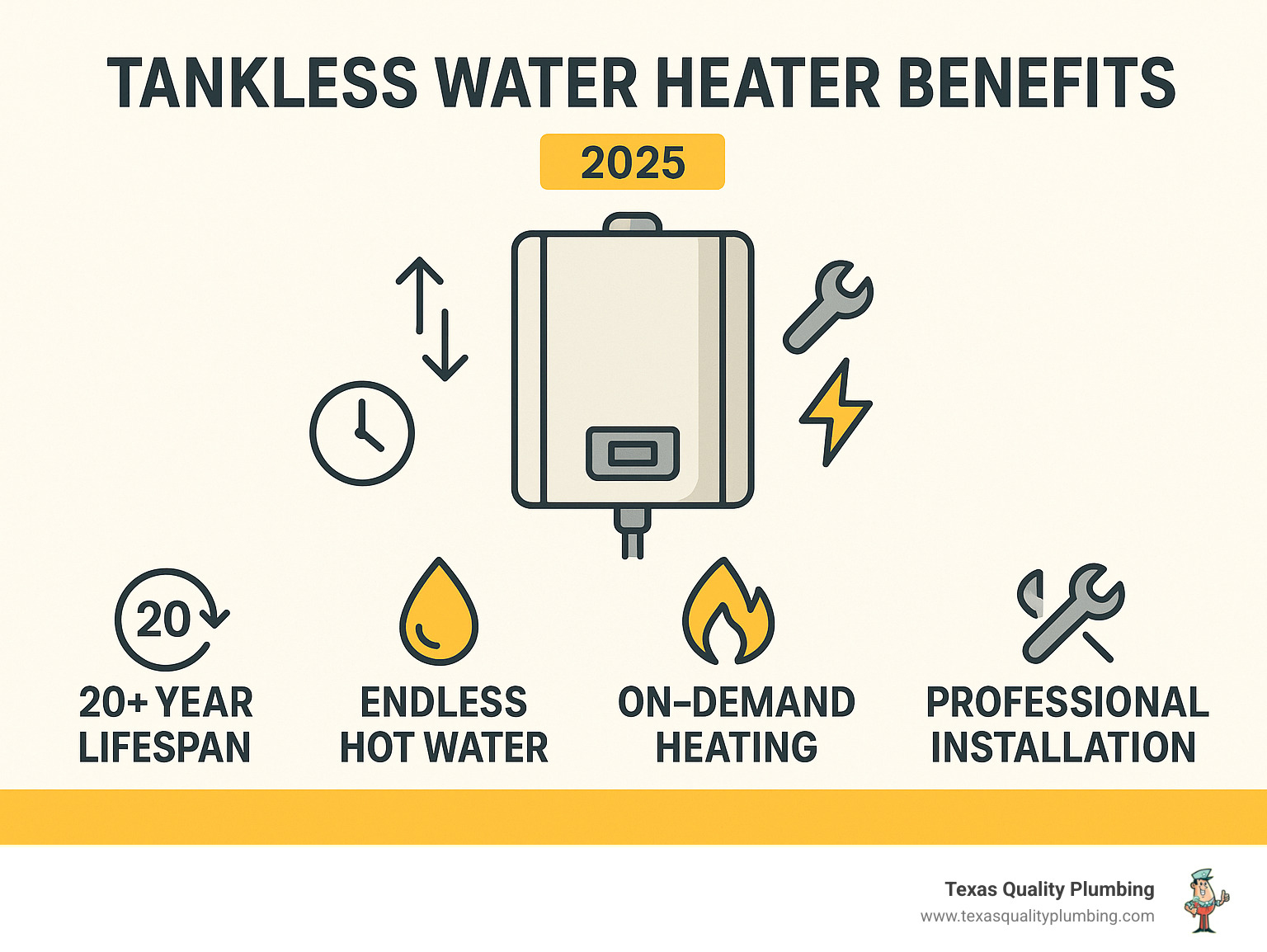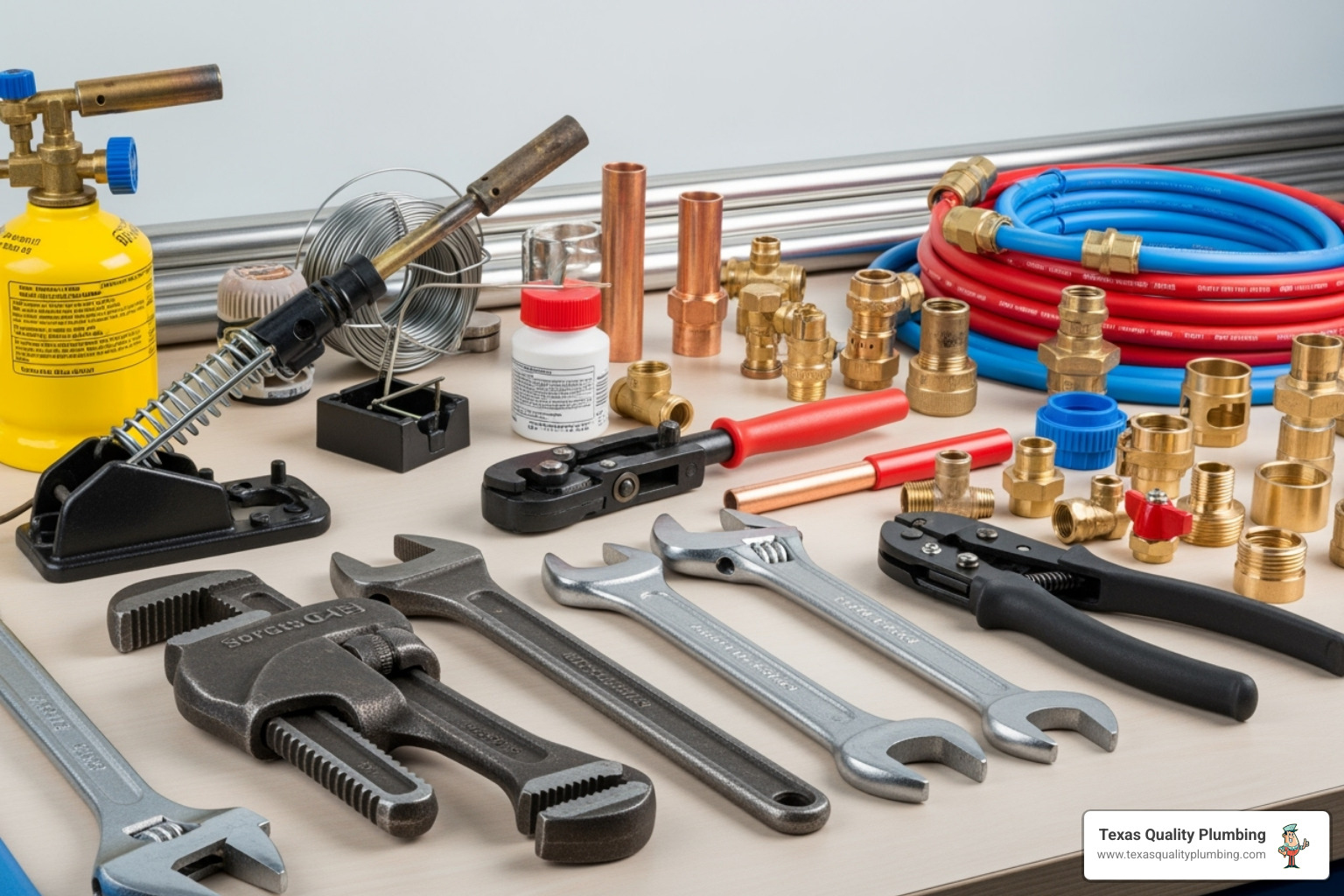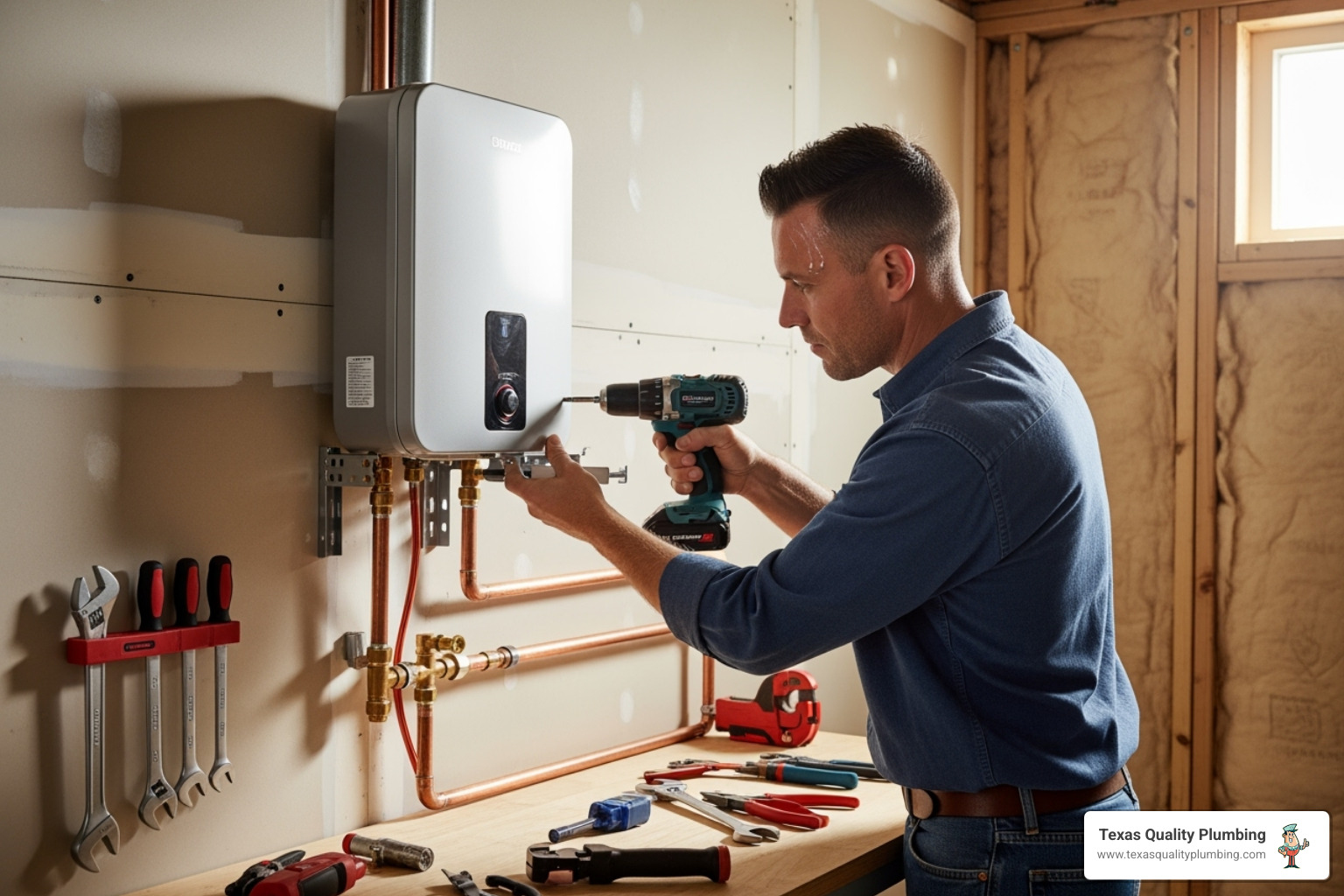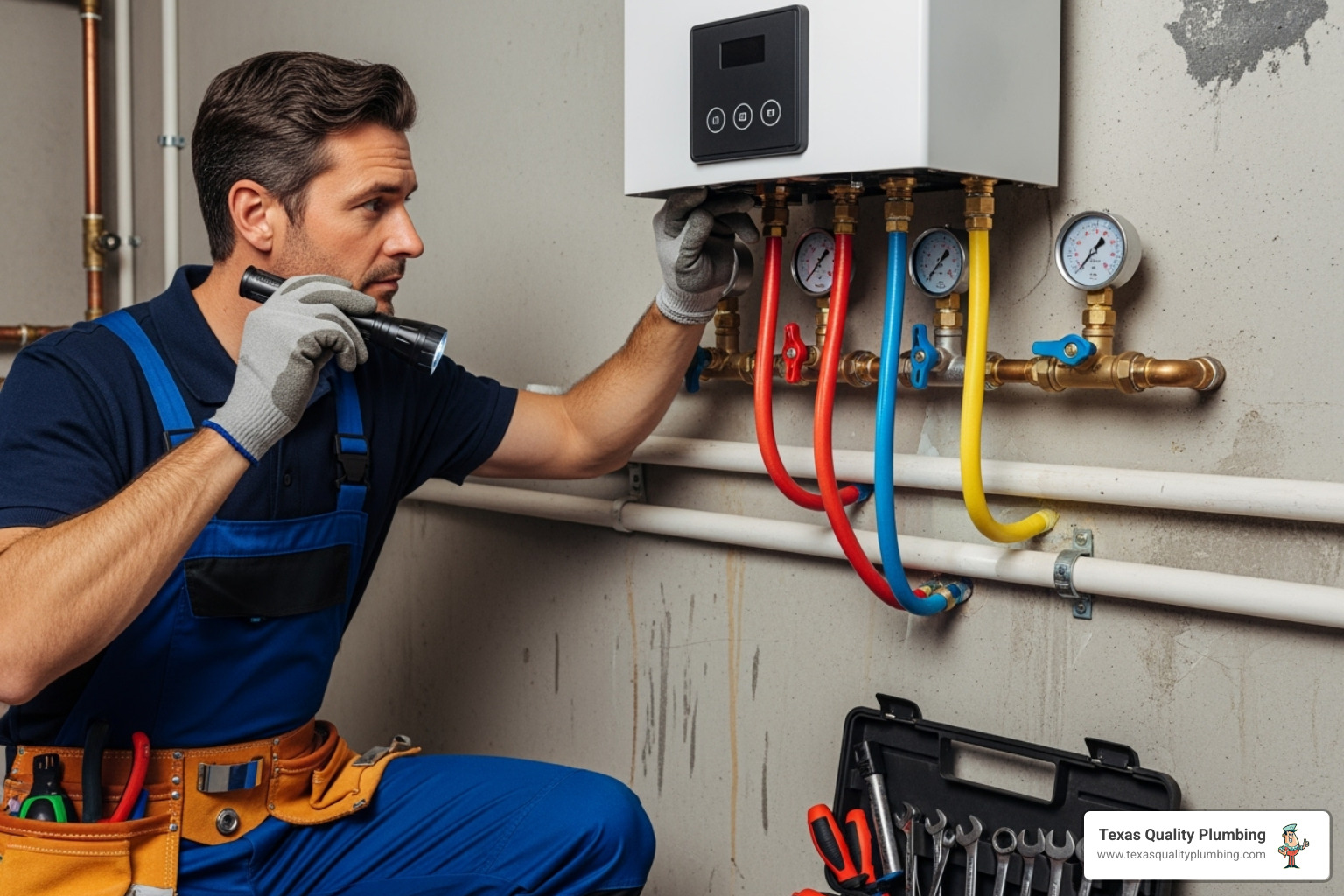Why Tankless Heater Install Is Your Best Investment for Endless Hot Water
Tankless heater install transforms how your home delivers hot water – switching from a bulky storage tank to an efficient, on-demand system that heats water only when you need it.
Quick Install Overview:
- Gas units: Require gas line upgrades, proper venting, and electrical connections
- Electric units: Need dedicated circuits and potential electrical panel upgrades
- Professional installation: Essential for safety, warranty protection, and code compliance
- Timeline: Typically 4-8 hours depending on complexity
- Key benefits: 20+ year lifespan, endless hot water, space savings up to 80%
Unlike traditional water heaters that constantly heat 40-80 gallons of stored water, tankless systems activate only when you turn on a hot water tap. This on-demand approach delivers several game-changing advantages for busy homeowners.
Energy efficiency tops the list – you’ll eliminate standby heat loss that wastes energy 24/7 with tank systems. The space-saving design frees up valuable storage area since these compact units mount on walls. Most importantly, you get an endless hot water supply that won’t run out during back-to-back showers or when running multiple appliances.
However, tankless heater install isn’t a simple swap. Gas units often need larger gas lines due to higher BTU demands (90,000-200,000 BTUs vs. 30,000-40,000 for tanks). Electric models frequently require new dedicated circuits and electrical panel upgrades. Proper venting, condensate drainage, and code compliance add complexity that makes professional installation non-negotiable.
The upfront investment runs higher than traditional tank replacement, but the 20+ year lifespan and energy savings create long-term value that tank systems can’t match.
Before You Begin: Planning Your Upgrade
Tankless heater install is a smart investment that pays dividends for decades. Here’s what you need to know before upgrading.
Why upgrade to tankless? The numbers tell a compelling story. A quality tankless system lasts over 20 years, nearly double the 10-15 year lifespan advantages of a traditional tank. You’ll replace it half as often.
While the upfront investment is higher, tankless systems eliminate the standby heat loss from constantly reheating stored water. This efficiency leads to real long-term savings on your utility bills—potentially up to $100 annually, depending on your usage. You also gain more utility room space and an endless supply of hot water. For a full breakdown, see our guide on Benefits of Tankless Water Heaters.
Here’s how tankless units stack up against traditional tanks:
| Feature | Traditional Tank | Tankless Water Heater |
|---|---|---|
| Lifespan | 10-15 years | 20+ years |
| Energy Efficiency | Constant heating (standby loss) | On-demand heating only |
| Space Required | Large floor footprint | Compact wall-mounted |
| Hot Water Supply | Limited by tank capacity | Endless supply |
| Monthly Utility Bills | Higher due to standby loss | Lower with on-demand heating |
Choosing the Right Tankless Water Heater
Picking the right tankless water heater depends on your home’s needs, existing utilities, and hot water habits.
Fuel type is your first choice. Gas tankless units heat water faster and often cost less to operate. Electric models are great for smaller applications and don’t require venting, but they need robust electrical service.
Sizing and capacity are determined by flow rate, measured in gallons per minute (GPM). A shower might use 2.5 GPM, while a sink uses 1.5 GPM. Add up fixtures that might run simultaneously to find your peak demand.
Temperature rise is how much the unit must heat incoming water. Higher BTU requirements handle greater temperature rises and flow rates.
Look for a high UEF rating (Uniform Energy Factor). This efficiency rating directly impacts your energy savings; higher numbers mean lower operating costs.
Condensing versus non-condensing units offer different efficiencies. Condensing models capture extra heat from exhaust, boosting efficiency but requiring a condensate drain. Non-condensing units cost less upfront but are less efficient.
Indoor versus outdoor installation affects your options. Indoor units need proper venting, while outdoor models require freeze protection.
For detailed guidance, visit our resource on choosing water heaters.
Understanding the Costs
A tankless heater install is an investment, and several factors influence the total cost.
Average unit prices vary by fuel type, capacity, and efficiency. Installation cost ranges depend on your home’s existing infrastructure. Simple replacements cost less than complex installations requiring major upgrades.
Several factors affecting cost can be significant. Gas line upgrades are common, as these powerful systems need more gas flow than tank heaters, often requiring larger pipes.
Electrical work is needed for electric models, which usually require dedicated circuits and possible electrical panel upgrades.
Venting requirements for gas units involve installing new, specialized vent pipes, as they cannot use traditional chimneys.
Don’t forget potential rebates from utilities or manufacturers, which can offset some upfront costs while you enjoy long-term energy savings.
The Step-by-Step Tankless Heater Install Process
Understanding the tankless heater install process highlights why professional installation is essential. Here’s a look at the key steps involved in changing your home’s hot water system.
First, safety precautions are paramount. We begin by shutting off utilities—the main water supply, the gas line to the old heater, and the electrical power at the breaker.
If replacing an old unit, draining the old system is next. We connect a hose to the drain valve, empty the tank, disconnect all lines, and safely remove the old unit. We also handle its disposal.
Having the right tools and materials is critical for a smooth installation. Our plumbers arrive with everything from pipe wrenches and soldering equipment to thread sealant and pressure gauges. Gas leak detectors and pressure gauges are essential for testing gas units thoroughly.
Essential tools for installation include pipe cutters, soldering torches, PEX crimping tools, levels, drills, measuring tape, safety gear, and heat-rated hoses. Each tool serves a specific purpose in ensuring a safe and reliable installation.
Preparing for Your Gas Tankless Heater Install
Gas tankless water heaters heat water rapidly but require significant preparation to operate safely and effectively.
Gas line sizing is often the biggest task. A new tankless unit demands 90,000 to 200,000 BTU/H, a major increase from a tank heater’s typical 30,000 BTU/H. This jump in BTU requirements usually means the existing gas line is too small, often requiring an upgrade. Sizing depends on the distance from the meter and other gas appliances.
Venting requirements are also different. Tankless gas units are direct-vent systems that require specialized stainless steel or PVC venting installed directly through a wall or roof. They cannot use old masonry chimneys. This ensures proper exhaust flow and prevents carbon monoxide buildup. For more details, see our guide on Tankless Water Heater Venting in Pasadena.
Adequate combustion air is crucial for the unit to burn fuel efficiently. High-efficiency condensing units also require a condensate drain to safely route acidic condensate away, sometimes through a neutralizer to protect plumbing.
Key Steps for an Electric Tankless Heater Install
Electric tankless water heaters have significant electrical power requirements.
An electrical panel assessment is the first critical step. These units often need multiple dedicated 40-amp 240-volt circuits, which may require a panel upgrade.
Dedicated circuit requirements are non-negotiable. We calculate the amperage needs and ensure your home’s service can handle the load. Proper wire gauge (often 8-gauge) is also critical for safety.
Point-of-use versus whole-house is a key decision. Point-of-use systems are installed near a specific fixture for instant hot water. Whole-house electric systems can serve the entire home but require even more robust electrical infrastructure.
We assess your usage and electrical setup to determine the best approach for your home.
Mounting and Connecting the Unit
Securing the unit to the wall is a major step. We mount it securely on a sturdy foundation, ensuring it is perfectly level and has proper clearances for venting and service.
Next are the water line connections. We connect the cold water supply to the inlet and the hot water outlet to your home’s system. All joints are cleaned, sealed, and tightened correctly to prevent leaks.
The pressure relief valve installation is a crucial, non-negotiable safety step that prevents dangerous pressure buildup. We install it according to manufacturer specifications and local codes. An expansion tank may also be needed if your system has a check valve.
Leak testing completes the connection process. We restore the water supply and visually inspect every connection. For gas lines, we use pressure gauges and leak detectors to confirm the system is perfectly sealed before turning on the gas. This meticulous approach ensures your new system is ready for years of reliable service.
Why Professional Installation is Non-Negotiable
While many homeowners are skilled at DIY projects, a tankless heater install requires professional expertise. The combination of high-power gas or electrical systems with high-pressure plumbing leaves no room for error. It’s a job that must be done right to protect your family and your home.
Code compliance is your safety net. Local municipalities have specific installation codes to prevent accidents. Professional plumbers are current on these regulations in Houston, Cypress, Spring, and other service areas, and we handle all necessary permits to ensure your installation is legal and safe.
Furthermore, manufacturer warranty validation almost always requires installation by a licensed professional. A DIY installation could void the warranty on your new unit, leaving you without protection.
The most critical reason for professional installation is avoiding severe safety risks. Improperly installed units can lead to gas leaks, which create an explosion risk, or faulty venting that causes deadly carbon monoxide poisoning. Electrical hazards from incorrect wiring can lead to house fires, and even minor water damage from a bad connection can result in costly repairs and mold growth.
At Texas Quality Plumbing, our licensed and insured plumbers bring years of experience to every tankless heater install. We manage all the complexities, ensuring every safety protocol is followed and every connection is tested. Ready for a safe, professional installation? Contact Texas Quality Plumbing for professional installation and get peace of mind with your investment.
Post-Installation Care and Maintenance
To keep your new tankless water heater running at peak performance for its 20+ year lifespan, regular maintenance is key.
The most important task is annual system flushing to remove mineral scale buildup from the heat exchanger. This scale acts as an insulator, reducing efficiency and potentially causing damage. Descaling is especially critical in areas with hard water. For more on this, see our guide on Tankless Water Heater Scaling Problems.
Regular filter cleaning is also necessary to maintain proper water flow and protect internal components.
Annual inspection benefits include professional flushing and descaling, plus a thorough check of all gas, water, and electrical connections. This proactive approach maintains peak efficiency, extends the unit’s lifespan, and catches minor issues before they become major problems.
Frequently Asked Questions about Tankless Heaters
Here are answers to the most common questions we receive during tankless heater install consultations.
How long does a tankless water heater last?
A new tankless water heater has an impressive average lifespan of 20+ years, which is nearly double that of a traditional tank water heater.
Factors that affect longevity are primarily within your control. Regular maintenance, like annual flushing and descaling, is the most important factor. Water quality also plays a role, as hard water can cause mineral buildup, but proper care will ensure your unit reaches its full lifespan. A professional installation also provides the right foundation for a long, trouble-free service life.
Can a tankless unit provide enough hot water for a large family?
Absolutely. Unlike tank heaters that can run out of stored hot water, tankless units provide a continuous hot water supply. The key is sizing the unit for your family’s specific demand.
We calculate your peak GPM (Gallons Per Minute) needs by adding up the flow rates of all fixtures that might run simultaneously. For example, if two showers (2 GPM each) and a dishwasher (1.5 GPM) are running, you need a unit that can handle at least 5.5 GPM. A properly sized unit manages this demand easily.
For very large homes or those with exceptionally high demand, we can install multiple units that work in tandem to ensure you never run out of hot water. If you’re concerned about sizing, our guide on Tankless Water Heater Size Problems provides more detail.
How much can I really save with a tankless water heater?
The energy savings mechanism is simple: a tankless unit only heats water when you need it. This eliminates the standby energy loss of a traditional tank heater, which constantly heats and reheats 40-80 gallons of water.
This on-demand heating leads to reduced utility bills. According to the U.S. Department of Energy, homeowners can save up to $100 per year on energy costs, depending on usage.
While the upfront cost of a tankless unit and professional installation is higher, the long-term ROI is significant. Over its 20-year lifespan, the accumulated energy savings, combined with the unit’s longevity, make it a sound financial investment. You also get the added benefits of endless hot water and extra space.
Enjoy Endless Hot Water with a Flawless Installation
You’ve explored the benefits and complexities of a tankless heater install, and it’s clear why so many homeowners are making this smart upgrade.
The advantages are compelling: a 20+ year lifespan that far outlasts traditional tanks, energy savings that can reduce utility bills by up to $100 annually, and the convenience of an endless hot water supply. The space-saving design is another valuable perk that adds to an investment that provides returns for years.
As we’ve covered, the importance of professional work is paramount. The complexities of gas lines, electrical upgrades, proper venting, and code compliance are safety essentials that protect your family and home. This is not a weekend DIY project.
This is where Texas Quality Plumbing expertise makes the difference. Our customer-focused approach means we solve problems quickly and accurately. Our licensed and insured plumbers don’t just install units; we ensure every connection is perfect, every code is met, and every safety measure is in place.
We understand the local conditions that affect your tankless heater install, from Houston’s hard water to Richmond’s specific building codes. We handle every detail, from sizing to final testing, ensuring your new system delivers the reliable, endless hot water you expect.
Ready to say goodbye to cold showers? Your family deserves the comfort and efficiency of a professionally installed tankless system. Contact us for your Richmond tankless water heater installation and let’s get your upgrade started today!





